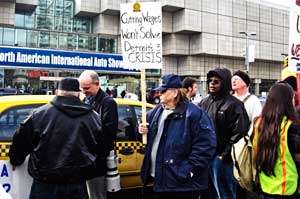Media day at the auto show
Autoworkers demand ‘No concessions!’
By
Martha Grevatt
Detroit
Published Jan 18, 2009 2:45 PM
“This is the show.” So brags the Web site of the North American
International Auto Show. It’s the place to be if you want to be
“the first to see the hottest new cars.”
|
Autoworkers picket in Detroit. Government
'bailout' plan rips up their
union contract.
WW photo: Cheryl LaBash
|
Yet on Jan. 11, opening day, the media of the world were focusing on an event
outside Detroit’s Cobo Center. More than 150 autoworkers held a militant
picket line to protest the concessions being demanded from the United Auto
Workers as part of a $17.4 billion government loan to General Motors and
Chrysler LLC.
“This whole thing about how we make so much more than foreign competitors
is a lie,” said Tony Browning, a 34-year Chrysler veteran. “We work
damn hard for our money and I don’t see a whole lot of people who are
going to vote to cut our paychecks in half.” (Detroit News, Jan. 11)
Popular chants included “No concessions” and “No jobs, no
peace.” The demonstration was called by Auto Worker Caravan, which last
month took a car caravan to Washington and confronted the anti-union senator
from Alabama, Richard Shelby.
Autoworkers have more than enough reasons to be concerned about their economic
future. While the UAW rank and file were picketing, they knew their leaders had
been meeting to discuss additional concessions.
Fearful of a GM or Chrysler bankruptcy if the companies did not get a federal
loan, leaders of UAW locals at GM, Chrysler and Ford agreed last month to
suspend the jobs bank. The bank pays workers most of their salary after 48
weeks of layoff. Prior to that the workers collect a combination of state
unemployment benefits and Supplemental Unemployment Benefits from a corporate
fund.
Abolition of both the jobs bank and SUB is one of the terms of the government
loan to the auto companies, without which repayment in full could be demanded
by March 31. The agreement signed by GM and the Treasury Department also
demands wage and benefit cuts from active workers and halts raises of retiree
pensions.
The loan comes due in 2011. Up until that time, workers at the Detroit Three
are prohibited from striking. This, the most outrageous provision of all, was
made public only in the past few days. (Associated Press, Jan. 9)
Such intrusive government meddling in the collective bargaining process and
denial of the right to strike is a flagrant violation of the 1935 National
Labor Relations Act.
Another threat to the UAW is a growing consensus in Washington and Wall Street
that Chrysler is history. Himanshu Patel, the public face of JPMorgan Chase,
“speculated” that “some sort of orderly down-stepping of
Chrysler may be in the works.” (Detroit Free Press, Jan. 8) In fact, this
Wall Street “auto analyst” has been agitating for a GM-Chrysler
merger for months. Not exactly neutral, Patel represents the bank that loaned
the New York hedge fund Cerberus the $6 billion it needed to buy Chrysler in
2007.
The bankers’ sentiments were echoed by both Democratic and Republican
members of the Senate Banking Committee during the hearings on the auto bailout
last year.
A compliant press is creating a case for Chrysler’s disintegration, with
headlines such as “Life on the Sinking USS Chrysler,” which
emphasizes that Chrysler sales for 2008 were down 53 percent over the previous
year. In fact every auto company in the world had double-digit drops in car
sales in 2008. (Detroit Free Press, Jan. 8)
Even with falling sales, Chrysler sold 300,000 more vehicles in 2008 than it
did in 1980, and its market share is 11 percent now versus 9.9 percent that
year. The company is building cars with at least 33,000 fewer workers than when
Cerberus bought Chrysler in August 2007.
Far more compelling than the media’s slanted statistics is the impact
Chrysler’s dismantling would have on the 66,000 remaining workers. The
business analysts discussing the future of the U.S. auto industry regard the
human cost of restructuring as irrelevant.
The rank-and-file workers, however, who stood out in the cold for hours on a
Sunday afternoon, are making their voices heard.
Articles copyright 1995-2012 Workers World.
Verbatim copying and distribution of this entire article is permitted in any medium without royalty provided this notice is preserved.
Workers World, 55 W. 17 St., NY, NY 10011
Email:
[email protected]
Subscribe
[email protected]
Support independent news
DONATE


